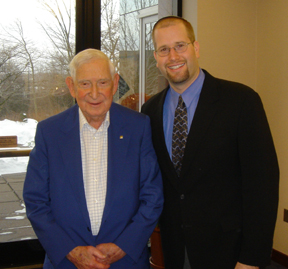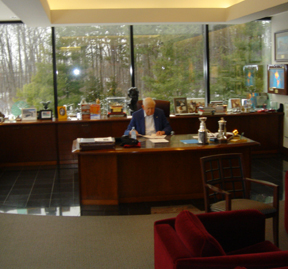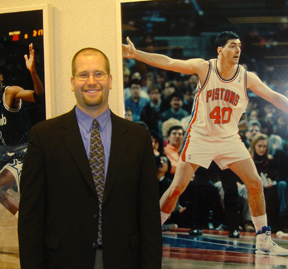Harry Plotzer and the Sanhedrin’s Stone
A Jewish parody of the first book of the kosher adventures of the Hogwarts hero.
by Doug Brook and available on Jewcy
Hat tip to Jewsweek
My colleague Rabbi Joshua Hammerman published this article in The NY Jewish Week. He is spot on with his analysis of the Conservative Movement.
Lately the Conservative movement has seemed less than concerned about conserving itself. The bad news has come in droves: budget woes at the Jewish Theological Seminary; the flap over gay marriage and ordination, highlighted by the unnecessary confrontation with Rabbi Ayelet Cohen of Congregation Beit Simchat Torah; all this topped off by declining demographics in the National Jewish Population Survey suggesting that nearly half of all those who grew up as Conservative Jews no longer identify as such.
These storm clouds have hidden from view significant events that could help return the movement to its historical centrality among American Jews. Over the past several weeks, the Rabbinical Assembly has for the first time made public on-line many of the key rulings of the fabled Law Committee. (You can find these responsa at http://www.rabbinicalassembly.org/law/teshuvot_public.html.)
This landmark move coincides with the publication of a new book, “A Place in the Tent,” by a small group of rabbis and educators on the West Coast who call themselves “The Tiferet Project.” The book posits a bold, more inclusive approach toward intermarried families, bypassing the normal channels of rabbinic debate and placing the subject squarely on the table to stimulate grassroots discussion.
The strength of Conservative Judaism lies in the creative tension that is at the core of its ideology. Given the choice, some people might prefer the “moral clarity” so in vogue, but like most of us, Conservative Judaism lives in a real world of tough questions. It thrives on the unresolved conflicts that force us to confront imperfection: Judaism’s, society’s and our own.
This muddle in the middle is an uncomfortable place to reside, but it is equally a dynamic one. So while other movements offer easy responses (which for Reform often is “Why not?” and for Orthodoxy, “No way!”), Conservatives look for the kind of dialectic that has been central to rabbinic Judaism since Talmudic times.
Synthesis doesn’t always mean compromise, but it always forces us to hear all views. There is no such thing as a knee-jerk Conservative response to anything. For those up to the intellectual challenge, it can be spiritually invigorating to wrestle with our traditions and texts rather than simply submitting to their authority or tossing them aside.
Amazingly, until very recently this enriching journey was not made easily available to most Conservative Jews. Clergy and educators had it, naturally, as did many attending Camp Ramah. But the text in the pews was the Hertz Chumash, which is about as reflective of the movement’s ideology as “Das Capital” is to the GOP. When the new Conservative Torah commentary, Etz Hayim, appeared in 2001, for the first time the laity began to “get it” and to engage en masse in that liberating grappling with Torah.
People suddenly felt free to ask when and how Exodus really happened. That produced oodles of bad press because the religious right was poised to attack and Conservative leaders weren’t prepared to fend it off. After all, grappling with the Exodus was nothing new to the movement’s elite; it’s something that had been done at the seminary for generations. But someone forgot to tell those outside the ivory tower who were busy swallowing Hertz’s spoon-fed apologetic in the pews.
And now, the next steps: the responsa Web site, public conversations about inclusivity and the demystification of the halachic process. At this site people will be fascinated to read about everything from the permissibility of stem cell research to the inclusion of the matriarchs in the Amidah prayer. They will become less intimidated by their rabbis, who no longer will be the sole possessors of these secrets — and rabbis will have less need to give dummied-down sermons. The focus will be less on ritual correctness and more on intense philosophical debate.
Readers might be surprised to discover that even minority opinions can be valid. There is a built-in elasticity to Conservative halacha, taking into account factors unique to each community and to every generation. This will be especially important as the Law Committee revisits the issues of gay and lesbian marriage and ordination. When that passionate dialogue becomes public, the media again will miss the point and harp on whether the center will hold. The center will hold precisely because it will shift, as it always does — most notably 20 years ago with the ordination of women. But with the leadership so concerned about unity and PR, the movement will miss yet another opportunity to revel in the creative tension that has spun off dynamic offspring for generations — everything from Kaplan’s Reconstructionism, Heschel’s activism and the Chavurah movement of the past century to the neo-Chasidic revivalism of today.
It is not surprising that Conservative Jews are the first to shun institutional labels, including their own. Labels are often prime indicators of stagnation, and there is nothing stagnant about those who routinely struggle with life’s most gripping questions. But the movement’s leadership too often finds itself preoccupied with putting out the fires rather than fanning these passionate flames that are its very soul.
Americans are craving an authentic spiritual alternative to “moral clarity.” It’s not just blue-staters who desire a few questions to go with all the pat answers.
Natan Sharansky, whom I deeply admire, has become the administration’s standard-bearer for clarity. What we now need is a poster child for nuance. We need someone like the sage Hillel, a leader humble enough to give credence to opposing views, one who can seek truth somewhere in the give-and-take, in the muddle of the middle. If and when Conservative Judaism realizes that there is passion in that delicious ambiguity and that most Jews want to live there, it will regain its institutional mojo. It may or may not be called Conservative when it does, but it will most certainly be Judaism. n
Rabbi Joshua Hammerman is spiritual leader of Temple Beth-El in Stamford, Conn.
Last Wednesday I had a very intriguing discussion over lunch with Mr. Bill Davidson, owner of Guardian Industries, and sports franchises the Detroit Pistons (NBA), Tampa Bay Lightning (NHL), and Detroit Shock (WNBA). Each of these sports teams are the reigning champions of their respective league.
I was invited to lunch with Mr. D. along with a few other recent graduates of the William Davidson Graduate School of Education at The Jewish Theological Seminary. I was very impressed with our candid discussion about the Seminary, Jewish Education, and the Conservative Movement. It was also impressive to tour Guardian Industries’ world headquarters (located in Auburn Hills) which looks out onto the Palace of Auburn Hills and the Pistons’ practice facility.
Here are some photos from the day:



A rabbi who has officiated at the marriage of gay and lesbian couples has been threatened with expulsion from the Conservative movement’s rabbinical association, though movement officials say it is not her activism that is at issue but her repeated defiance of the movement’s rules.
Ayelet S. Cohen, the junior rabbi at Congregation Beth Simchat Torah, a largely gay and lesbian synagogue in Greenwich Village, says she is being punished for her openness in performing the ceremonies. Officials of the association say it has nothing to do with the gay marriages. Rather, they say, she faces expulsion because she has repeatedly defied long-established rules for taking a job at a synagogue.
The Rabbinical Assembly of the Conservative movement, with 1,600 rabbis, voted in 1992 not to ordain gays as rabbis and said that rabbis should not perform same-sex marriages. But the assembly stopped short of declaring the ban on marriage or commitment ceremonies a binding standard, tacitly allowing individual rabbis some discretion. Various rabbis within the movement have estimated that 20 to 40 rabbis have performed these ceremonies. Both the Reform and Reconstructionist movements ordain people who are gay and allow rabbis to marry gay people. Orthodox Jews neither ordain nor marry gays.
Rabbi Cohen said the assembly’s Joint Commission on Rabbinic Placement told her in recent days that it would recommend her expulsion from the assembly for taking a job at an unaffiliated synagogue without obtaining a waiver and, after getting a waiver, letting it expire. Officials confirmed that part of her account, and said her case would be heard on Jan. 25 by the assembly’s administrative committee and on Jan. 26 by the executive council, whose decision would be final.
Expulsion would make it virtually impossible for Rabbi Cohen to get jobs at 760 North American synagogues affiliated with the Conservative movement, or to use the movement’s pension and insurance plans. She could continue serving at Beth Simchat Torah, which was discouraged from joining the Conservative movement and has not affiliated itself elsewhere.
In an interview before leaving for a vacation in Spain, Rabbi Cohen, who is 30 years old and heterosexual, said she was being punished for her vocal advocacy on gay rights.
“It’s because I have performed same-sex wedding ceremonies,” Rabbi Cohen said. “I made it clear from the outset that I plan to do it, and I have done it.”
Rabbi Cohen, whose father is Stephen P. Cohen, president of the Institute for Middle East Peace and Development, has performed four wedding ceremonies for people of the same sex, having them exchange vows under a chupah, or canopy, and having them sign a ketubah, or marriage contract. Last March, she was interviewed by The New York Times after charges were brought against two Unitarian ministers for performing same-sex ceremonies in New Paltz for couples who did not have marriage licenses. She said at the time that she would “continue to conduct ceremonies, even if illegal.”
Rabbi Joel H. Meyers, executive vice president of the Rabbinical Assembly, denied that Rabbi Cohen’s activism on gay issues had anything to do with the charges against her, and added, “She’s no more public about it than other rabbis.”
Rather, he said, she is facing sanctions because of her repeated defiance of bedrock rules on how rabbis get placed, rules that prevent synagogues from poaching one another’s rabbis with lucrative offers.
Rabbi Cohen was ordained at the Jewish Theological Seminary, the movement’s fountainhead, in May 2002 and took a job at the unaffiliated Greenwich Village synagogue before being formally granted a waiver to do so. Rabbi Meyers eventually gave her a waiver for two years, but Rabbi Cohen let it be known that the time was insufficient. By July 31, 2004, she should have applied for an extension but did not, waiting two months beyond the waiver’s expiration.
“It’s painful and unfortunate,” Rabbi Meyers said. “Ayelet Cohen is a very good rabbi. She gets people to talk about her positively in terms of her work, and it’s a shame she’s raising this – trying to push this off on the movement and its gay and lesbian stance – rather than looking at her own actions.”
Rabbi Cohen has received a letter of support from eight colleagues, including Rabbi Gordon Tucker of Temple Israel in White Plains, the former dean of the seminary’s rabbinical school, and Rabbi J. Rolando Matalon of Congregation B’nai Jeshurun on the West Side. Noting that the movement has lost gay members and their families, the eight rabbis wrote: “Surely the opportunity to have Rabbi Cohen serve a community of gay and lesbian Jews who seek a Conservative rabbi is too important to be thrown away in favor of punishing her for such a technical error.”
Whatever happens to Rabbi Cohen, the issue is not going to go away. The assembly’s committee on Jewish law and standards is meeting in April and will revisit the issue of gay and lesbian unions.
Ten-and-a-half years ago I came to Mamshit Camel Ranch, a Bedouin Village, close to Demona in the Negev desert in Israel. I was a participant on USY Israel Pilgrimage (Group 3) and celebrated my 18th birthday in the Bedouin tent. To my young eyes it appeared to be a fairly realistic Bedouin experience complete with Bedouin food, sleeping in a tent, and camel rides. I wasn’t naive — of course I knew that the Bedouins who worked at Mamshit lived in the nice homes nearby and didn’t live as the Bedouins of ages past.
Now, as a staff member on a birthright israel trip with University of Michigan and Harvard students, I am sitting in the main office of Mamshit (Israeli owned) checking my e-mail and posting to my Blog on a high-speed DSL connection.
I’d write more but there’s a camel-riding Bedouin waiting to check his stock portfolio online!
Study finds doctors take supernatural into account
By Chanan Tigay
NEW YORK, Dec. 23 (JTA) — In the 1980s, when Rabbi Leonard Sharzer was still working as a plastic surgeon, he treated a patient suffering from a debilitating neurological disease. Sharzer and his colleagues agreed that the man wasn’t long for this world.
“It was clear to everybody taking care of him that there was nothing more that could be done,” said Sharzer, who was ordained as a Conservative rabbi in 2003. “His family expected this. We didn’t know how long he would survive. He was on a downhill course and the outcome was clear.”
But then something strange happened.
“He just lingered and lingered and lingered for six or eight weeks — and he got better,” Sharzer recalled. “There was no way to explain that medically.”
“Looking back on it today,” Sharzer added, “I think I probably would have called it miraculous.”
As it turns out, Sharzer is not alone: According to a new survey, the majority of American physicians believe in miracles.
The study, carried out by HCD Research and the Louis Finkelstein Institute for Religious and Social Studies of The Jewish Theological Seminary in New York, found that 74 percent of U.S. doctors believe miracles have happened in the past, and 73 percent believe they can occur today.
Among Jewish doctors, 88 percent of Orthodox respondents said they believed miracles have transpired, as did 53 percent of Conservative respondents, 46 percent of Reform respondents and 29 percent of those identifying as culturally Jewish.
The numbers were approximately the same when the doctors were asked if miracles can occur today.
Like Sharzer, 55 percent of physicians surveyed said they had seen treatment results in their patients that they would consider miraculous.
The study also found that 55 percent of the doctors surveyed believe medical practice should be guided by religious teaching, and nearly 40 percent are convinced that the biblical miracle stories — such as Exodus’ parting of the Red Sea — are to be taken literally.
Among Jews, 53 percent of Orthodox doctors believe literally in the biblical miracles, as do nearly 12 percent of Conservative respondents, more than 4 percent of Reform and 2 percent of culturally Jewish respondents.
According to Alan Mittleman, the Finkelstein Institute’s director, the study indicates that the conventional sociological wisdom holding that religious belief declines as a person’s scientific education grows is false.
“The big picture was that doctors are really not less religious than their patients,” he said. “I was somewhat surprised by the overall religiosity of the physicians.”
The survey of 1,087 physicians — Christians, Muslims, Hindus, Buddhists and 253 Jews — also found that 20 percent of Jewish doctors believe supernatural events or acts of God frequently influence treatment outcomes. Among Catholics that number rose to 35 percent, and jumped again to 46 percent among Protestants.
Among the Jews surveyed between Dec. 17-19, 94 identified themselves as Conservative, 93 as Reform, 49 as culturally Jewish and 17 as Orthodox. The survey had a margin of error of 2.9 percentage points.
Orthodox Jewish doctors, the study found, were closer to their Christian counterparts with regard to supernatural views than they were to Conservative and Reform doctors.
“Reform and Conservative Jewish physicians seem to be more focused on the medical aspects and their potential for outcome,” said Glenn Kessler, co-founder and managing partner of HCD Research, a private market research company in Flemington, N.J., that deals largely with pharmaceutical companies.
“Orthodox Jews, Catholics and Protestants appear to be more open to non-medical reasons for outcomes — supernatural, unexplained reasons.”
Sharzer, who as a surgeon performed reconstructive operations on people who had been injured in accidents, recalled a patient who arrived at the hospital in critical condition.
“He had a whole group of friends and colleagues come into the hospital, and they began chanting around the clock for three or four days, maybe a week, while he was in extremely critical condition,” Sharzer said.
“When he started to wake up he was aware that they were doing it. From an anecdotal standpoint — patients who are in very dire straits, their own faith and faith in their family certainly can have a beneficial effect.”
He added, “The longer you are in practice the longer you can see things that you can’t explain on the basis of your own actions and your own abilities.”
Funny selections from Jewsweek’s Jewriffic Awards.
Best reference to child molestation:
“Rabbi Feldman, stop touching me!”
— Adam Sandler on the Tonight Show with Jay Leno explaining what he was thinking when the director of his new movie, Spanglish, told him to channel a time from his childhood that would make him cry on cue.
Best rip-off of Fiddler on the Roof by a hot woman: Gwen Stefani riffs on Fiddler on the Roof on her new CD Love, Angel, Music, Baby with the song “Rich Girl,” a take off of Tevye’s “If I were a rich man”.
“Now that you’ve let the secret out that I’m not Jewish, I expect my career to be done. Thank you very much. I appreciate that. My career is officially over.”
— Jason Biggs thanking the women of “The View” for alerting the world to the fact that he’s not Jewish.
Best piece of political critique: “I don’t think I’ve ever seen a time when the party that controlled the Senate, the House, the White House and the Supreme Court was so out of sorts about how little respect they get. At a certain point you want to say, “OK, Goliath. Stop pretending.”
— Jon Stewart writing about the recent elections in Rolling Stone Magazine.
Our parsha this week tells of the transformation of an individual, our forefather Jacob. This personal transformation also lays the foundation for the creation of a people, Israel. The Torah teaches that Jacob was left alone in the dark when an angel wrestled with him until the break of dawn. When Jacob’s adversary saw that he had not prevailed against him, he dislocated Jacob’s hip at its socket. He then pleaded that Jacob let him go, but Jacob would not let him go until he was blessed. At this point our ancestor’s name is altered from “Jacob” to “Israel.”
During the course of a summer at Camp Ramah (and throughout several summers as well) campers experience a personal transformation much like Jacob. Many campers find that Camp Ramah is a comfortable venue for wrestling with one’s Jewish identity. The summer is a time for self-discovery and renewal. It is a time for both campers and staff to engage in the opportunities and challenges of wrestling with God and matters of faith and spirituality. May we all celebrate in the blessing of our children who have the Ramah experience to struggle, seek, change, and grow. Perhaps it is truly during the summer that our future generations show us the path from simply being like Jacob, lonlely strugglers, to becoming Israel, our holy community.
LINDA MOREL
Jewish Telegraphic Agency
Did you know that Thanksgiving is really a Jewish holiday?
Although Thanksgiving is not on the Jewish calendar, historians believe Sukkot may have inspired America’s favorite farewell to fall, often nicknamed “Turkey Day.”
“The pilgrims based their customs on the Bible,” says Gloria Kaufer Greene, author of the “New Jewish Holiday Cookbook” (Times Books, $29.95 hardcover). “They knew that Sukkot was an autumn harvest festival, and there is evidence that they fashioned the first Thanksgiving after the Jewish custom of celebrating the success of the year’s crops.”
Linda Burghardt, author of “Jewish Holiday Traditions” (Citadel Press, $24.95 hardcover), says, “Sukkot is considered a model for Thanksgiving. Both holidays revolve around showing gratitude for a bountiful harvest.”
Today Thanksgiving is celebrated on the fourth Thursday of November, but President Franklin Roosevelt didn’t propose this timing until 1939.
It was Abraham Lincoln who made Thanksgiving a national holiday. Roosevelt actually changed Lincoln’s decree that Thanksgiving be observed on the last Thursday in November, which sometimes fell on the fifth Thursday of the month.
The pilgrims invited local Indians to the first Thanksgiving during the fall of 1621. Historians speculate that this celebration occurred somewhere between Sept. 21 and Nov. 9, but most likely in early October, around the time of Sukkot.
“Originally, Sukkot entailed a pilgrimage to Jerusalem,” says Greene, who believes the two holidays share much in common. […more…]
The evening was sponsored by the Sloppy Joe group, which was an interesting side note. The Sloppy Joe group, a men’s poker and dinner club, began a number of years ago when a women’s Rosh Chodesh group started at the synagogue. A photographer was there to take pictures for an upcoming article on Torah on Tap (Jewish) and Theology on Tap (Christian) to be published in New Jersey Monthly Magazine.